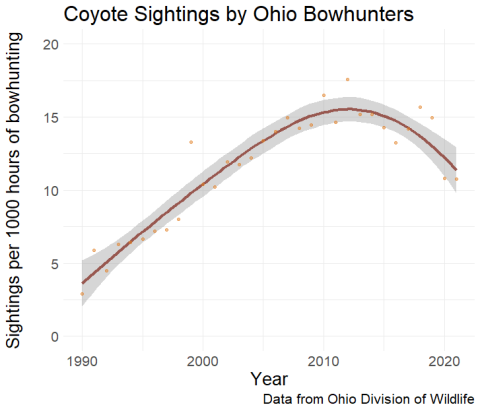Coyotes in the US
Prior to around 1700, coyotes were restricted to the western US and Mexico, predominantly in prairie and desert ecosystems. During the last century, coyotes have greatly expanded their geographic range to encompass eastern North America, in part due to the eradication of larger carnivore species.
Given their presence as the largest predator across most of this area, and that they have not only increased range but also appear to have increased in abundance, it is predictable that their success has been intertwined with fascination, condemnation, controversy, and conflict.
Coyotes in Ohio
In Ohio, coyotes were first recorded in the state in 1919 (Weeks et al. 1990). After decades of low abundance and presumably slow population growth, the statewide coyote population began to increase dramatically, as seen in the graph to the right. Currently, the coyote is well-established across all Ohio’s counties, and it is clearly the apex terrestrial predator in the state. Ohio is not unique, as this pattern of colonization and subsequent increase in abundance has played out in virtually every eastern state.
Numerous genetic studies have investigated the coyotes of the eastern US and their relationship to western coyotes and other North American canids. Different genetic methods being used has led to some confusion about eastern coyotes. Though coyotes in the East do have more admixture with other canids, they are still predominantly coyote and prefer to breed with other coyotes.
References:
Weeks, John L, Gildo M Tori, and Mark C Shieldcastle. 1990. Coyotes (Canis latrans) in Ohio. Ohio Journal of Science 90(5):142-145.

